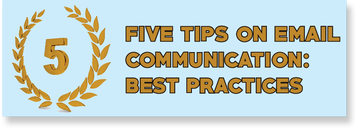
As the way we communicate in writing has evolved — from letters and telegrams to email and text — some of the rules to ensure we communicate effectively have changed with these various mediums.
At the same time, most rules for effective written communication are of the golden variety, meaning they apply across any platform and can muck up an otherwise innocuous message.
We’ve all been there, whether it’s a big ol’ typo in your introduction, or an email so massaged that your original thought and its fourth iteration meet up in an embarrassingly incoherent way.
From choosing a word open to misinterpretation, or a paragraph so long Melville would sooner be drowned by his big white whale, we can avoid easily caught errors with a few simple steps.
Lastly, but not surprisingly, the National Association of Colleges and Employers’ 2020 survey listed written communication in its top five categories of critical skills prospective employees need to be considered for hire.
Since email has become the business world’s principal way of communicating between co-workers and to most company’s clients, let’s dive into some tips.

NO. 1 | TONE
*Rule of thumb: when someone reads your email, interpreting the tone can be difficult without the benefit of non-verbal cues or ability to ask follow-up questions.
“What specifically do you want?”
Even if there are words that appear before or after that question, this question is not “direct,” it’s just rude. The question makes the person you are communicating with feel like they are bothering you.
“I can’t”; “they can’t”; “it can’t”; “unfortunately we can’t”;
“we don’t”; “I am unable.”
Avoid the habit of saying “no” over e-mail, it’s bad form. When an employee writes, “I can’t,” the rest of the email is rendered irrelevant. If you must say “no” to something, try to do it in person or over the phone.
Reach out to the person and explain why you are saying no.

NO. 2 | EXPEDITIOUS RESPONSES
*Rule of thumb: When someone sends you an email with anticipation of your reply, try and be mindful of their expectation.
“I’ve been in meetings.”
This phrase implies you are more important than the individual you are communicating with.
(The only time this phrase is appropriate is if it’d accompanied by an apology for a delay in reply and, if you apologize, you likely don’t need to explain why it took so long in the first place.)
If you communicate with the person frequently, set an expectation you will respond to e-mails during specific times of day; nobody will wonder where you are.
Pro Tip: Encourage your stakeholders to reach out via text or phone if it’s urgent.
“I am unavailable.”
Everyone at work is unavailable at times — not just you. If you can’t meet with someone, just tell him or her when you are available. Instead consider: “I can meet on Monday or Wednesday, between 11 a.m. and 2 p.m. Is either of these days good for you?”
‘Out of Office’ Message: “I am unavailable.”
“I am unavailable”; wow, really? It’s redundant. Try this: “I will be out of the office for the next two weeks with limited access to email, but your message is important to me. I appreciate your patience with my delayed response.”
Pro Tip: If you have the resources, suggest a person who may be contacted in your stead.

NO. 3 | TERSENESS
* Rule of thumb: an email is not a text message (different blog post) and shouldn’t be drafted as such. While brevity is effective, giving a terse reply or edict is off-putting. Emily Post may seem antiquated, but her name is synonymous with etiquette for a good reason: manners matter.
“This is too late.”
While letting someone know they blew a deadline is not unreasonable, there’s no need to be brusque.
Pro Tip: Don’t close the door on a possibility.
Instead of focusing that someone was late or missed a deadline, try this: I appreciate you’re getting X to me, but my deadline for it has passed. However, it possible for us to grab 15 minutes and discuss next steps?”
“Do you have …?”; “Can you …?”; or “You should …”
Again, abruptness leads to resentment. As I tell my kids: be a
mensch. If you are uniformly considerate, it’s hard for someone to impugn your character. (Yes, it’s sometimes easier said than done.)

NO. 4 | SEEDING CONFUSION
“Let me know if there’s a further issue.”
Avoid ending your communication with an expectation the person will have a problem. When I received this message, I no longer felt confident about the information included in the e-mail.
Make sure your e-mail expresses a tone of confidence, not uncertainty: “Please let me know if the information included in this e-mail is helpful.”

NO. 5 | SPELL CHECK & READ ALOUD
“Dear [misspelled name] … “
For goodness sake, if nothing else make sure the name of the person you are writing to is spelled correctly. While people may overlook typos in texts, it’s hard to ignore your name misspelled in an email or letter — or any communication.
Re-read and spell check your communications, and pay extra attention to people’s names. Ask a colleague to check your presentations.
Pro Tip: Read your letter aloud and you will catch many awkward phrases or grammar mistakes that your eyes will gloss over in a silent proofread. The step of audible proofreading is the next best thing to having an editor by your side.
Remember: Any contact you have with a person is an opportunity to build or enhance a relationship. Anyone you interact with could be a future partner, stakeholder or customer.
